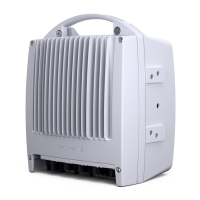MINI-LINKEandEMicro
3.12 Traffic Routing
The built-in software cabling between the indoor units within an AMM offers:
• Reduced requirement for external cabling at repeater
and multi-terminal
sites which means higher reliability and lower instal
lation and cable costs.
• Reduced requirement for SMUs in s ome configurations, w hich means that
hardware costs can be reduced.
• 8 Mbit/s traffic connections on the SMU (8x2 and 16x2) fronts which m eans
that multiples of both 2 M bit/s and 8 Mbit/s traffic connections are available.
The interconnections are made in the backplane and it is controlled from a PC
with the MINI-LINK Ser vice Manager (MSM ) or t he MINI-LINK Netman. A traffic
routing setup is possible from any node in the network.
The following pages include three examples of traffic routing.
Example 1: Traffic routing at a repeater site
In this example two 2 Mbit/s channels are repeated from one terminal to
another. The two terminals at the repeater site (called Feeder and Sub-link in
the figure below) are connected through the backplane of the access module.
2x2 Mbit/s
Feeder
Sub-link
Outdoor units
Access module
1+0
AMM
2x2 Mbit/s
1+0
Feeder
Radio Unit
Backplane
MMU 2x2
Sub-link
Radio Unit
MMU 2x2
3544
Figure 54 Traffic routing at a 2x2 Mbit/s repeater site
74 AE/LZT 110 2012 R8C 2002-03-04

